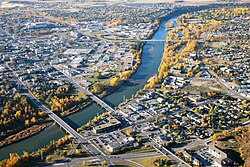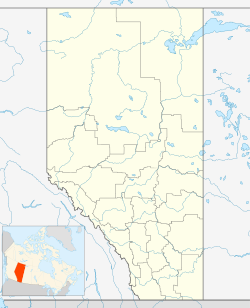Red Deer, Alberta
| Red Deer | |||
|---|---|---|---|
| City | |||
| City of Red Deer | |||

Aerial view of Downtown Red Deer
|
|||
|
|||
| Motto: Education, Industry and Progress | |||
| Location of Red Deer in Alberta | |||
| Coordinates: 52°16′05″N 113°48′40″W / 52.26806°N 113.81111°WCoordinates: 52°16′05″N 113°48′40″W / 52.26806°N 113.81111°W | |||
| Country | Canada | ||
| Province | Alberta | ||
| Region | Calgary–Edmonton Corridor | ||
| Census division | 8 | ||
| Founded | 1882 | ||
| Incorporated | |||
| • Village | May 31, 1894 | ||
| • Town | June 12, 1901 | ||
| • City | March 25, 1913 | ||
| Government | |||
| • Mayor | Tara Veer | ||
| • Governing body |
|
||
| • City Manager | Craig Curtis | ||
| • MPs |
Earl Dreeshen (CPC), Blaine Calkins (CPC) |
||
| • MLAs |
Barb Miller (NDP), Kim Schreiner (NDP) |
||
| Area (2016) | |||
| • Land | 104.73 km2 (40.44 sq mi) | ||
| • Urban | 62.91 km2 (24.29 sq mi) | ||
| Elevation | 855 m (2,805 ft) | ||
| Population (2016) | |||
| • City | 100,418 | ||
| • Density | 958.8/km2 (2,483/sq mi) | ||
| • Urban | 99,718 | ||
| • Urban density | 1,585.2/km2 (4,106/sq mi) | ||
| • Municipal census (2016) | 99,832 | ||
| Demonym(s) | Red Deerian | ||
| Time zone | MST (UTC−7) | ||
| • Summer (DST) | MDT (UTC−6) | ||
| Postal code span | T4N to T4R | ||
| Area code(s) | 403, 587, 825 | ||
| Highways | 2, 2A, 11, 11A, 595 | ||
| Waterways | Red Deer River, Waskasoo Creek, Piper Creek | ||
| Website | Official website | ||
Red Deer is a city in Central Alberta, Canada. It is located near the midpoint of the Calgary–Edmonton Corridor and is surrounded by Red Deer County. It is Alberta's third-most-populous city – after Calgary and Edmonton. The city is located in aspen parkland, a region of rolling hills that is home to oil, grain, and cattle production. It is a centre for oil and agriculture distribution, and the surrounding region is a major centre for petrochemical production. Red Deer had a population of 100,416 in 2016.
Prior to European settlement, the area was a gathering place that was inhabited by Aboriginal tribes including the Blackfoot, Plains Cree and Stoney. European fur traders began passing through the area in the late eighteenth century. Into this ethnic mix, the Métis peoples also emerged.
A native trail ran from Montana in the south across the Bow River near Calgary and on to Fort Edmonton. About halfway between Calgary and Edmonton, the trail crossed the Red Deer River at a wide, stony shallow used by First Nations peoples and bison, commonly known as buffalo, since ancient times. The shallows, now known as the Old Red Deer Crossing, are about 7 kilometres (4.3 mi) upstream from the present City of Red Deer.
With the establishment of Fort Calgary by the North-West Mounted Police in 1875, traffic increased along what was by then known as the Calgary and Edmonton Trail. After the arrival of the Canadian Pacific Railway in Calgary, traffic along the "C & E" trail increased substantially. A trading post and stopping house were built at the Crossing in 1882 and a permanent settlement began to develop around it.
...
Wikipedia



